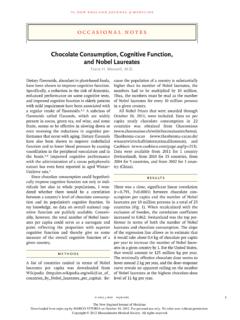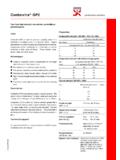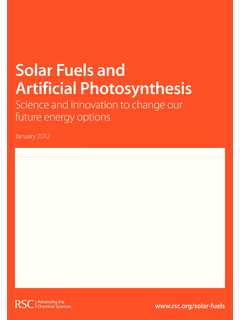Transcription of WHO Position Statement (June 2012)
1 1 WHO Position Statement (June 2012) Effectiveness of Non-Pharmaceutical Forms of artemisia annua L. against malaria _____ The world health organization (WHO) recommends artemisinin-based combination therapy (ACT) for the treatment of uncomplicated malaria due to Plasmodium falciparum (P. falciparum). ACTs recommended by WHO combine an artemisinin derivative such as artemether, artesunate or dihydroartemisinin with an effective antimalarial medicine. The five currently recommended ACTs are listed in the WHO guidelines for the treatment of malaria, 2010 (1).
2 A number of herbal remedies made of artemisia annua L. (A. annua ) dry leaves are suggested for the treatment and prevention of malaria. However, WHO does not recommend the use A. annua plant material ,in any form, including tea, for the treatment or the prevention of malaria. The WHO recommendation is based on the review of scientific findings. Firstly, the content of artemisinin in the leaves is influenced by many genetic, agricultural and environmental factors (2-4 ). Total recovery of artemisinin can vary from to weight% of dry leaf mass (4-5 ).
3 Harvesting season, drying procedures and storage conditions also influence the content in artemisinin (6-8). A. annua leaves stored at temperatures above 20 C with high relative humidity cause a substantial loss of artemisinin content (6), which makes it imperative to store the leaves in cool and dry conditions. Crushing the leaves before storage can also affect the artemisinin content (6). People living in rural areas may not have adequate storage facilities in their homes to ensure that the content of artemisinin is fully maintained over long periods of time.
4 For these reasons home-grown A. annua should not be recommended to serve as a self-reliant supply of artemisinin in any form, including tea, for the treatment or the prevention of malaria. Secondly, patients who are treated for malaria with A. annua tea are likely to be under-dosed. For example, using artemisinin-rich plant material, R th et al, (9) showed that the highest concentration of artemisinin released in 1 litre of A. annua tea is still less than 20% of that which is contained in a 500 mg pharmaceutical dose of artemisinin.
5 This is because artemisinin is poorly soluble in water and unstable at high temperatures (10). Studies have 2 also shown that the duration of contact with water, ratio of plant material to water and filter type affect the extraction efficiency (9, 11). In order to receive a dose equivalent to a 500 mg artemisinin tablet or capsule, patients would be required to drink as much as 5 litres of A. annua tea per day, for a minimum of seven consecutive days, making compliance to treatment difficult to achieve.
6 In practice malaria patients are drinking only 1 litre of A. annua , thus receiving a dose of artemisinin insufficient to eliminate the parasites. Such sub-curative doses could promote the emergence of P. falciparum resistance to artemisinins. In the past, mass exposure of the parasites to small ineffective doses of chloroquine led to the emergence and spread of chloroquine resistance in endemic regions (12). Resistance to artemisinin has already been reported (13) and animal models with rodent malaria showed that resistance to artemisinin can develop rapidly as a result of repeated exposures to sub-therapeutic doses (14).
7 Thirdly, data from two independent, controlled, randomized clinical trials in semi-immune adult malaria patients showed unacceptable rates of recrudescence. In these studies, patients were administered one litre of tea containing either 5 or 9 g of dry leaves per litre, each day, for 7 days, a regimen usually recommended by tea suppliers (15,16). In both studies, treatment failure rates largely exceeded the acceptable limit set by WHO. The situation could worsen in non-immune patients when the tea is taken at home, without medical supervision, as this population is at risk of developing severe malaria.
8 Other preparations of A. annua , in form of compacted plant material, have been suggested as an alternative to tea. One study has shown an increased bioavailability of artemisinin in animals who received artemisinin in planta compared with animals receiving pure artemisinin powder (17). The authors considered that the presence of essential oils in the plant improved artemisinin absorption. It has also been suggested that several known active substances in A. annua act synergistically with artemisinin to elicit a more potent antimalarial activity (17-1 9).
9 However, the high recrudescence rate observed in clinical studies (15-16) suggests that even if these constituents do act synergistically with artemisinin, these interactions are insufficient to eliminate Plasmodium parasites and cure malaria. 3 In conclusion extensive fundamental and clinical research would be required to demonstrate that non-pharmaceutical forms of A. annua , including tea bag, are safe and effective to treat malaria and that their dissemination would not promote the development of artemisinin-resistant parasites.
10 REFERENCES 1. WHO (2010). Guidelines for the treatment of malaria, 2nd ed. Geneva, world health organization . 2. Delabays N Simonnet X and Gaudin M (2001). The Genetics of Artemisinin Content in artemisia annua L. and the Breeding of High Yield Cultivars. Current Medicinal Chemistry, 8: 1795-1801. 3. Ferreira JFS et al. (2005). Cultivation and genetics of artemisia annua L for increased production of the antimalarial artemisinin. Plant Genetics Resources, 3(2): 206-229. 4. WHO (2006). Monograph on good agricultural and collection practices (GACP) for artemisia annua L.
















